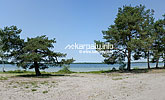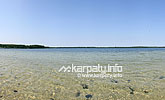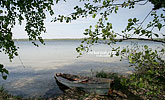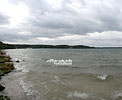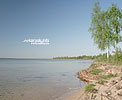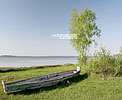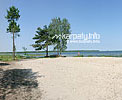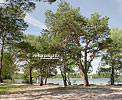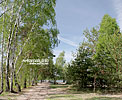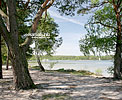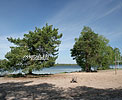SHATSK National Park
Shatsk National Park was established on the 28th of December, 1983. It covers an area of 48977 hectares. The park is formed on the basis of the national landscape reserves 'Krymne lake', 'Pisochne lake', 'Pulemetske lake', 'Svityaz lake', zoological natural landmark 'Klymivske lake', the hydrological landmarks 'Luky marsh', 'Melevane marsh' and 'Piddovhe-Pidkrugle marsh'. The botanical reserve of national importance 'Vtensky' is also included (130 hectares); forest reserves of the local importance: 'Rostansky' (14,6 hectares) and 'Yalynnyk' (83 hectares), ichthyological reserve 'Somynets' (46 hectares) and 4 natural monuments of local importance. In 2002 the park was included in the International Net of the Biosphere Reserves within the frames of the UNESCO Program 'A Man and a Biosphere'.
The territory of Shatsk National Park is located in the western part of one of the largest swamp- lake- forest complexes in Europe — the Polissya region (northern Ukraine, southern Belarus, partially Poland and Russia). Here are typical ecosystems for Western Polissya lakes, forests, marshes and meadows.
There are 23 lakes within the park, with a total area of 6338,9 hectares. These are typical Polissya lakes, of lower areas of the relief, formed as a result of rocks' washing out, settling of the ground and related to the lowering and raising of some tectonic blocks.
The climate is moderately continental, humid, with mild winters, unstable frosts, significant rainfalls, cool summers. Winter is characterised by frequent thaws, light rainfalls. The westerly winds prevail that soften temperature regime.
The peculiar features of the park's geological structure and climate, numerous lakes have influenced the character of vegetation of the park. Forests cover about 56% of the park, marshes — 2,7%, water basins (lakes, ponds, channels) — almost 14%. Forests , mostly pine, are concentrated in the eastern part of the park. The most common are bilberry-pine forests. Local marshes differ, depending on the peat layers and the type of vegetation. The most common are low-lying (eutrophic) bogs. Meadows are situated in the eastern part of Prypyat' river.
The Green Book of Ukraine includes 14 rare plant communities. Among them there are leucobryum pine forest, bilberry-pine, pine-fir, oak-pine hazel forests. Among rare marsh vegetation there are: Scheuchzerietum (palustris) sphagnosum (S. fallax, S. flexuosum), Caricetum (lasiocarpae) scheuchzerioso (palustris)-sphagnosum (S. cuspidatum), Сaricetа davallianae, Cládium (Fen-sedge); waterс — Aldrovanda vesiculosa (waterwheel plant), Nymphaea alba (European White Waterlily) and Nymphaea candida, Nuphar lutea (Yellow Water-lily), Sparganium minimum (small bur-reed), Potamogeton crispus (curled pondweed) and Potamogeton obtusifolius (blunt-leaved pondweed), Ceratophyllum demersum (hornwort).
The flora of the park numbers 795 species of vascular plants. There grow 110 species of mosses, 265 species of diatoms, 75 species of true fungi. 28 plant species are listed into the Red Book of Ukraine: Betula humilis, Cypripedium calceolus (lady's-slipper orchid), Cephalanthera rubra (Red Helleborine), Neottia nidus-avis (Bird's-nest Orchid), Liparis loeselii, Platanthera bifolia, (lesser butterfly-orchid), Oxycoccus microcarpus, Drosera anglica (English sundew) and Drosera intermedia (oblong-leaved sundew), Crassulla, etc.
The fauna of the park is typical for the forest and wetland complexes. The fauna is represented by species typical for Polissya: elk, European roe deer, wild boar, European hare, squirrel. Among predatory mammals there are: European pine marten, stoat, weasel, European polecat, fox, rarely — beech marten, badger, river otter, raccoon dog and wolf. There are few representatives of bats (Daubenton's bat, long-eared bat, serotine bat, common noctule, common pipistrellus). In general there are 333 species of vertebrates here: 29 species of fish, 12 species of amphibians, 7 species of reptiles, 241 species of birds, 44 species of mammals. Among invertebrates: 31 species of molluscs, 71 species of crustaceans, 244 species of arachnids, 110 species of insects. 9 species are listed in the European Red List, 33 species — to the Red Book of Ukraine. Rare inhabitants of the park are the following: natterjack toad, smooth snake, black stork, Bewick's swan, squacco heron, Horned owl, red kite, common eider, common firecrest, Miller's water shrew, stoat, etc. Western Polissya is considered to be an important region for preservation of globally endangered species of birds — aquatic warbler, as well as the following species: grouse, marsh sandpiper, common crane, etc, being endangered in Europe. This region is an important resting place for birds during migration.
The park is a well-known developed recreation area. There are 4 rest zones: 'Hryada', 'Svityaz', 'Hushove tract' and 'Pisochne'. A large number of resorts, sanatorium, sports and summer camps, numerous campings are located on the shores of the lakes. Recently, the park has been hosting an annual international song festival 'On the waves of Svityaz'.
Shatsk district
Svityaz village
Phone.: +38 (03355) 9-46-23
+38 (03355) 9-46-64
Fax: +38 (03355) 2-95-15
E-mail: shpark@sh.lt.ukrtel.net

 Ukraine
Ukraine Poland
Poland Slovakia
Slovakia
 Українською
Українською